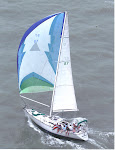Last
year's cruise was dominated by problems with the Yanmar motor which
powers the White Pepper.
This year the main problem has been with the Yamaha 8 HP which powers
the dingy Habanero. There
is no comparison, of course, but today's event were memorable.
We
had the Yamaha serviced at Vero Marine Center and had a rusted
throttle cable replaced with considerable expense and delay over
Christmas at Vero Beach, FL. That is were the problems started.
Performance was great the day after service. However, problems
developed soon afterward. By the time White Pepper
had arrived at Great Harbour Cay, the motor would barely start and
would run only at full throttle. It seemed as if the idle jets were
clogged in the carburetor. Some improvement was made by adjusting
the idle screw. At this point I had decided to buy a new motor in
George Town, Bahamas as the cost of service was exceeding the value
of the motor. Also we were limited to motoring no further than we
could row back to the boat which is no fun when cruising.
I
guess that the Yamaha knew that the end was near and decided to
commit suicide. On a very windy and bumpy night the Yamaha jumped
off the stern of the dingy into 20 feet of water while at anchor off
Lee Stocking Island.
The
next morning after discovering the accident a friend took me into
George Town were I ordered a replaced motor-- an Enduro Yamaha 8 HP.
In the meantime I had to get the motor off the bottom if for no other
reason than to prevent fouling someone's anchor.
Conventional
wisdom is to take the spark plugs out, turn the motor upside down,
hose it down with fresh water, drain the carburetor, replace the
spark plugs, and start it right away.
I
chose a different path. I partially disassembled the motor, washing
and cleaning the parts. The carburetor was exhaustively cleaned.
There was considerable debris inside which was probably old
“varnished” gasoline. The high speed jet was clean, the low speed
jet less clean, and idle jets were clogged. The idle jets are not
really jets on the Yamaha—rather they are just holes and tunnels
near the choke valve. Steve from Red Boat
was very helpful pointing out these fine details that never show up
in manuals or You-tube videos. It took all of one afternoon to
disassemble the motor and all of the next morning to reassemble it.
Finally, I was ready to try to start it. I would love to tell the
reader that it started on the first pull, but that didn't happen. I
had dedicated myself to 100 pulls on the the starting rope. However,
I could not get that far. My sense was that there was still water in
the cylinders. I removed the spark plugs and began to pull on the
starting rope. A foam of water and WD-40 sputtered out of the holes.
Eventually only gasoline seemed to be coming out of the spark plug
holes. I replace the plugs with new ones. Here at this point I would
again love to tell the reader that the motor started—it didn't. I
returned to the 100 pulls. Finally, on the very last pull the Yamaha
truly miraculously sputtered to life and ran.
Because
I had meticulously cleaned the carburetor the motor actually runs
better than before the dunking. I can now idle it down to almost
nothing. There are still problems with the motor. Some folks say the
2 stroke engines can last forever. I do not believe them. Things
wear out, although I could have taken better care of this particular
motor. I do plan to use the new engine. I think, however, that I
will keep the old one as a souvenir.
(As
an aside, 2 stroke Yamaha motors are reasonably priced in the Bahamas
when nothing else is. Yamaha is the only brand available, and they
are ubiquitous. I have been told that the price did go up when 2
stroke engines were banned in the US.)

No comments:
Post a Comment